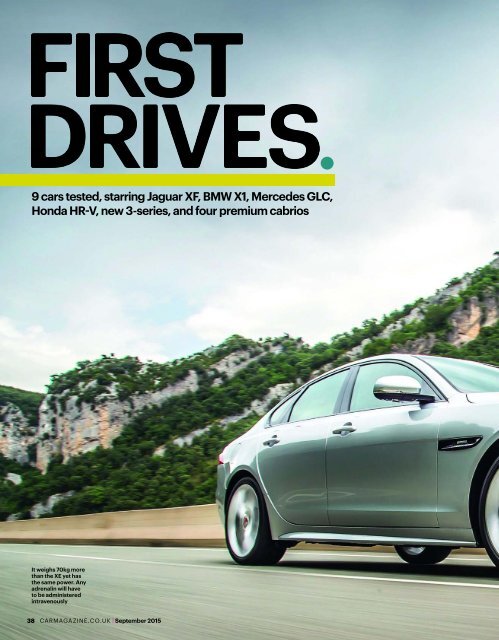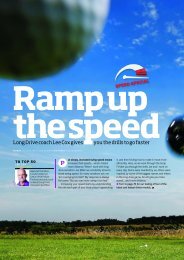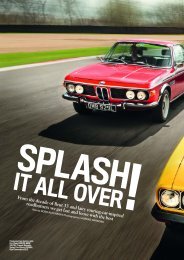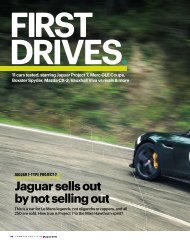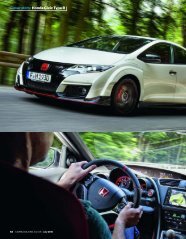Car September 2015.pdf
- No tags were found...
Create successful ePaper yourself
Turn your PDF publications into a flip-book with our unique Google optimized e-Paper software.
9 cars tested, starring Jaguar XF, BMW X1, Mercedes GLC,<br />
Honda HR-V, new 3-series, and four premium cabrios<br />
It weighs 70kg more<br />
than the XE yet has<br />
the same power. Any<br />
adrenalin will have<br />
to be administered<br />
intravenously<br />
38 CARMAGAZINE.CO.UK | <strong>September</strong> 2015
BARRY HAYDEN<br />
YOU’LL SWEAR THE new Jaguar<br />
XF is longer than its predecessor:<br />
that tiny front overhang, the feature<br />
line that visually elongates the body,<br />
the boot that dangles beyond the<br />
rear axle like a cliff-hanging Italian Job bus. All of<br />
it makes the new XF appear a long car. It is quite<br />
long at 4954mm, but it’s actually 7mm shorter<br />
than the outgoing model, 3mm lower too.<br />
If you’ve ever sat in the back of the old XF,<br />
fashioning a new one to be shorter and lower<br />
wouldn’t be top of your wish-list: the rakish roof<br />
made it more cramped for rear-seat passengers<br />
than 5-series, E-class and A6 rivals. Yet sit in the<br />
back of the new model and you’ll find plenty of<br />
legroom – a class-leading 15mm more than before,<br />
claims Jag, courtesy of a wheelbase stretched 51mm<br />
to 2960mm –more headroom than a blue-sky<br />
meeting, and a view out of the windscreen that’s<br />
far less claustrophobic. There’s a big boot too,<br />
though at 540 litres it’s no larger than before; that<br />
7mm has to come from somewhere.<br />
So, new XF looks bigger, is actually smaller,<br />
but has more room inside. It’s the kind of packaging<br />
voodoo made possible only with an all-new car,<br />
and XF marks the second appearance of Jaguar’s<br />
scalable aluminium-intensive architecture. Just<br />
like one-segment-down XE before it, there’s<br />
double-wishbone front suspension, a multi-link<br />
‘Integral Link’ rear axle and a body split<br />
approximately 75/25% aluminium to steel, where<br />
the old model was 100% steel.<br />
This familiarity, together with the matryoshkadoll<br />
design, is strategic: Jag is pooling its cars on<br />
a common platform to boost economies of scale<br />
(the F-Pace SUV is spun off it too), and is sticking<br />
with a common design language to establish<br />
modern Jaguar on the world stage. But if you’re in<br />
the market for this car, that background doesn’t<br />
make it a less exciting prospect.<br />
You sit low in seats that are supportive if on<br />
the firm side of comfortable, and when you press<br />
JAGUAR XF<br />
Haven’t we<br />
met before?<br />
Jaguar channels Audi’s ‘all models look alike’<br />
strategy with an XF that looks like an XE…<br />
but with proper room in the back<br />
<strong>September</strong> 2015 | CARMAGAZINE.CO.UK 39
UP AGAINST<br />
BETTER THAN<br />
BMW 5-series<br />
Former benchmark now overtaken<br />
WORSE THAN<br />
Jaguar XE<br />
Not an obvious rival, but smaller<br />
sibling has the dynamic edge<br />
WE’D BUY<br />
Jaguar XF<br />
– if you need the<br />
extra space<br />
Take a dollop of XJ,<br />
add a generous splash<br />
of XE and season with<br />
a pinch of old XF<br />
the XF’s starter button the rotary gear controller<br />
rises from the centre console and the air vents rotate<br />
as a welcome, just as they used to. This time, though,<br />
only the outer vents rotate, which feels a bit<br />
disjointed to me.<br />
The rest of the dash is a mix of XJ, old XF and<br />
new XE, and generally looks good, with the XJ-style<br />
‘Riva Hoop’ that wraps round the top of the dash<br />
and flows into the door casings, the thick XF-a-like<br />
fillet of trim that sits above the glovebox, and the<br />
new InControl Touch touchscreen that banishes<br />
the old unintuitive infotainment system. The trim<br />
appears better than the XE’s, though the hollow<br />
clacks when you tap the door casings and the<br />
barren-looking gear-control surround diminish<br />
perceived quality.<br />
Move off and the electrically assisted steering<br />
feels meatier than both the previous XF and today’s<br />
XE. There’s precision as soon as you twist it offcentre,<br />
very consistent weighting and accuracy, and<br />
a flightiness to its responses that quickly hints at<br />
sporting intent. I like it, but I do miss the fingertip<br />
delicacy of the last XF’s hydraulic rack. We’re on<br />
20-inch rims and passive R Sport suspension – not<br />
the continuously variable dampers – which has a<br />
little float to absorb bumps, but can stray into<br />
fidgetiness on rougher surfaces. On the mix of rural<br />
and urban roads and Spanish autoroutes we’re<br />
driving, it quickly sinks into the background,<br />
though; good compromise, I’d say.<br />
When Jaguar launched the first XF in 2007, there<br />
were no four-pot diesels, no estate in the product<br />
plan, and no all-wheel-drive variants either. Those<br />
omissions were rectified over time, which partly<br />
explains why the XF sold more units in its final<br />
year than at any other time. But it didn’t get off to<br />
the strongest start as a result.<br />
This time’s a different story. At launch, there are<br />
four engines: 161bhp and 178bhp four-cylinder<br />
Ingenium diesels to court the fleet market, a 296bhp<br />
V6 turbodiesel, and a 3.0-litre supercharged V6,<br />
though the 375bhp version, not the 335bhp fitted to<br />
the XE. There are also four trim levels: Prestige,<br />
R-Sport, Portfolio and S.<br />
We’re driving the model expected to account for<br />
most sales: the 178bhp diesel R Sport. The £36,850<br />
sticker is bang on German territory (or £32,300 for<br />
entry-level 161bhp Prestige), and the promised<br />
65.7mpg and 114g/km CO2 are<br />
similarly comparable (70.6mpg/104g/<br />
km for XF’s 161bhp diesels is currently<br />
best-in-class). Sizeable elephants<br />
heading for the room include the<br />
soon-to-be-replaced Mercedes E-class<br />
and BMW 5-series.<br />
Jag says our XF’s 318lb ft torque<br />
peak hits from 1750rpm, and you can<br />
feel the turbo whoosh kicking eagerly<br />
from 1500rpm. It lends some real<br />
flexibility, but don’t forget the XF fields<br />
the same four-pot diesels with the<br />
same power outputs as the XE, yet<br />
weighs a claimed 70kg more (we’d<br />
guess more than that). So while the<br />
178bhp diesel feels pretty lusty in the XE, here it<br />
provides adequate rather than plentiful thrust. It’s<br />
not the sweetest sounding motor either, with more<br />
mooing than a milk shed when you extend it; the<br />
Volvo XC90 I drove to the airport better disguised<br />
its cylinder deficit.<br />
But this powertrain also marks a big<br />
improvement over the previous 2.2-litre diesel and<br />
its eight-speed auto. The old motor was a bit of a<br />
thrasher, something not helped by the auto<br />
gearbox’s bid to get to the tallest<br />
ratio as quickly as possible, then<br />
select the shortest one the<br />
LOVE<br />
Handling,<br />
refinement<br />
(mostly), space,<br />
frugality<br />
HATE<br />
Mooing engine,<br />
firm seats, some<br />
interior quality<br />
VERDICT<br />
Your commute<br />
just got more fun<br />
★ ★ ★ ★ ★<br />
moment you wiggled a toe. The<br />
Ingenium motor is significantly<br />
more refined, and the generous<br />
torque and/or better calibration<br />
allows the ’box to hold higher<br />
ratios under acceleration. You can<br />
also order a manual for the first<br />
time, which cuts price and –<br />
sometimes – CO2 emissions,<br />
which rather undoes talk of<br />
ultra-efficient eight-speed autos<br />
and super-tall cruising ratios.<br />
Need more speed? The next<br />
40<br />
CARMAGAZINE.CO.UK | <strong>September</strong> 2015
Jaguar’s terrific chassis<br />
compromised by long<br />
wheelbase and lack of<br />
power, but XF is still a<br />
mighty impressive steer<br />
Shorter and lower than before, but<br />
with a longer wheelbase, XF somehow<br />
conjures more room in the back<br />
step up is a big one, to the familiar twin-turbodiesel<br />
3.0-litre V6, which now makes 296bhp. It starts from<br />
£50k, and returns 51.4mpg and emits 144g/km.<br />
The closely related single-turbo V6 isn’t on the<br />
launch menu, so you have to surmise that it’ll be<br />
the twin-turbodiesel Ingenium four that plugs the<br />
gap and satisfies company execs in a rush. Where<br />
are the Ford-sourced four-cylinder petrols, the ones<br />
that’ve surprised Jag with their popularity in the<br />
XE? No mention of ’em: JLR is readying its own,<br />
Midlands-built Ingenium petrol fours.<br />
Anyway, once you get our XF up<br />
to speed it’s a good entertainer.<br />
Point the nose into a corner and<br />
there’s a little lull as the weight<br />
drops down and compresses the<br />
inside front wheel. Feel the weight<br />
settle, the steering get meatier, then<br />
accelerate and you’ll carve through<br />
the bend in a blur. Then you’ll realise<br />
you could’ve gone faster; the way<br />
that double-wishbone suspension<br />
keeps the front end fluster-free even<br />
when you really throw the XF at an<br />
apex is pretty remarkable.<br />
Despite the commonality with<br />
XE, the XF didn’t blow me away like the baby Jag<br />
did. The longer wheelbase makes it feel less agile, the<br />
lower power-to-weight ratio gives you less to work<br />
the chassis with, and when you really push your luck<br />
with some very high entry speeds, the nose will<br />
ultimately lose its composure and push wide where<br />
the XE just seems to stick. I complained about<br />
barbecuing XE’s stoppers, but the XF has actual<br />
firelighters for brake pads.<br />
As ever, talk of pushing dynamic boundaries is<br />
of only partial relevance in this market. If you drive<br />
the XF just a little below them, you’ll find it a very<br />
entertaining, refined, frugal and spacious place to<br />
be. I prefer driving it to the current German<br />
opposition. It’s just that I prefer driving the XE<br />
more. So before you buy, ask yourself how much<br />
you need more rear space and a larger boot...<br />
BEN BARRY @IamBenBarry<br />
Jaguar XF R Sport<br />
> Price £36,850 > Engine 1999cc 16v four-cylinder<br />
turbodiesel, 178bhp @ 4000rpm, 318lb ft @ 1750-<br />
2500rpm > Transmission Eight-speed auto, rearwheel<br />
drive > Suspension Double-wishbone front,<br />
Integral Link rear > Performance 8.1sec 0-62mph,<br />
136mph (limited), 65.7mpg, 114g/km CO2 > Weight<br />
From 1595kg > On Sale Now<br />
<strong>September</strong> 2015 | CARMAGAZINE.CO.UK 41
Who offers the best sky bundle?<br />
BMW’s 2-series ups the ante among the premium small cabrio elite, makingVauxhall’s<br />
extraordinarily audacious bid to join the club look an increasingly big ask. By Steve Moody<br />
Volkswagen Golf cabriolet<br />
BMW M235i convertible<br />
What’s the story?<br />
Volkswagen might mean the ‘People’s <strong>Car</strong>’, but the Golf<br />
cabriolet is shorthand for ‘Posh People’s<br />
<strong>Car</strong>’. The ubiquitous droptop for the<br />
world of Daily Mail outrage and kids<br />
at public school, and as timeless<br />
as a Laura Ashley tablecloth.<br />
What’s the story?<br />
New 2-series cab is wider, longer and more sharky<br />
looking than the 1-series it replaces, and sixcylinder<br />
322bhp M235i is expensive but<br />
blisteringly fast. A convertible in a<br />
muscle vest. 181bhp 220i M Sport<br />
is far cheaper and almost as fun.<br />
Chopping the roof off: has it<br />
worked?<br />
Puppy-cute with the roof up<br />
thanks to the stubby boot, it’s<br />
less agreeable with roof down<br />
because it messily stows like a badly<br />
packed kebab. Rather drab-sided, loafer<br />
profile not the sexiest either.<br />
Must write angrily<br />
to the Daily Mail<br />
Chopping the roof off: has it<br />
worked?<br />
The ungainly looking fabric roof<br />
retracts with a gentle stretch and<br />
a long yawn, taking 20 seconds,<br />
although you can do it at over<br />
30mph. Stows neatly too, not needing a<br />
big box to drop into.<br />
Must chat up the<br />
ladies captain<br />
ALEX TAPLEY<br />
Will they blackball me at the tennis club?<br />
No chance. You’ll be head of the social committee in<br />
no time. Popular and coquettish without being too<br />
loud, politically steering a neutral course through the<br />
machinations of the end-of-season ball.<br />
Will they blackball it at the tennis club?<br />
Showy and loud, with sexy angular lines and a glittery<br />
grille, the BMW is far more flash than the Golf or A3 – more<br />
Sandbanks or Surrey than Middle England. Scandal no<br />
doubt awaits with the club captain.<br />
46 CARMAGAZINE.CO.UK | <strong>September</strong> 2015
Does the fact we had<br />
to dodge the showers<br />
to shoot this sum up<br />
the folly of cabrios in<br />
the UK climate?<br />
Audi A3 cabriolet<br />
Vauxhall Cascada Elite<br />
What’s the story?<br />
Transport for the Tatler set, Lady Di’s gym-tripper gets a<br />
modern makeover with this MQB-based<br />
car, which is larger and intended to<br />
have a more distinctive personality<br />
than the last version. Meaning it’s<br />
no longer just an expensive Golf.<br />
Must renew my<br />
Tatler subscription<br />
What’s the story?<br />
Effectively an Astra saloon (yes, they do exist,<br />
somewhere in Europe) with the ceiling pulled down,<br />
the Cascada is a big, long car at nearly 4.7<br />
metres and a heavy one too. Vauxhall<br />
claims it is an A5 rival. It’s not.<br />
Chopping the roof off: has it<br />
worked?<br />
If you see rain coming, better<br />
get ready early: the roof takes<br />
a long time to do its thing (18<br />
seconds against the Golf’s 10), but it<br />
cleverly resides in a tray that means the<br />
275 litre boot isn’t affected much.<br />
Chopping the roof off: has it worked?<br />
Rocking an ’80s theme, the Farah<br />
Stay-Press burgundy-and-black fleck<br />
roof isn’t the most contemporary<br />
colour, but the return to cloth from the<br />
metal bridgework of the Astra Twin Top is<br />
welcome. It stows pretty quickly but loses 100<br />
litres of bootspace in the process.<br />
Must not go on<br />
EBay when drunk<br />
Will they blackball it at the tennis club?<br />
Lager shandies all round in the clubhouse: the A3 is<br />
stylish and oozes class in every one of its finely trimmed<br />
and brushed details. In the A team in no time, and the<br />
leery tennis coach will be all over you like a rash.<br />
Will they blackball me at the tennis club?<br />
There might be some raised eyebrows due to the Vauxhall<br />
badge, for this is a market where badge snobbery<br />
oneupmanship is rife, but the Cascada’s rarity might<br />
swing it. Expect to be playing doubles in the D team<br />
though, with Clive the bottom fondler.<br />
CONTINUED…<br />
<strong>September</strong> 2015 | CARMAGAZINE.CO.UK<br />
47
CONTINUED…<br />
Volkswagen Golf cabriolet<br />
Drop-top flip-flop slip-slop load of plop?<br />
Notably more shuddery than the Audi, with bird pooresistant<br />
wipe-clean harder cabin materials, it does feel<br />
a step down. The stiff suspension is clearly trying to<br />
mitigate for some flex, but makes the ride a bit brittle.<br />
BMW M235i convertible<br />
Drop-top flip-flop slip-slop load of plop?<br />
Stiffer than a triple G&T, the BM’s wheels hang off a structure<br />
that seems to have no flex whatsoever. Cabin has none of<br />
the Audi’s sleek artistry, and the metallic door pulls look like<br />
nightmarish gynaecological instruments. Well made though.<br />
Easy to clean,<br />
even after a<br />
cormorant<br />
fly-past<br />
Looks quite<br />
nice, rides<br />
like a vintage<br />
traction engine<br />
Hacking about or a fine drive down the middle?<br />
Bimbling along humming Club Tropicana is the Golf’s<br />
thing. Not exactly powerful, it needs to be chivvied through<br />
each gear, although the light steering is nicely direct.<br />
Over-servoed brakes will have passengers spilling their<br />
Cornettos if you’re not careful.<br />
Do we still need Derek’s Saab estate?<br />
Yes. Even a Calais tunnel migrant might baulk at trying to<br />
sneak into the Golf’s tiny boot. If they’ve got long legs, they<br />
might even struggle in the rear seats too. For once even the<br />
magical MQB platform can’t free up enough space.<br />
Verdict<br />
Nice, fresh and inoffensive like cucumber sandwiches, the<br />
Golf is a very lovely way to travel about on a sunny day.<br />
Ideal for the quietly smug.<br />
Hacking about or a fine drive down the middle?<br />
The best car to drive by a mile, and with the roof down<br />
sounds like somebody has put dynamite in a French<br />
horn. But it’s not near the coupe or hatchback, even if the<br />
numbers suggest it is: near 1.7-tonne weight has turned the<br />
2 from bolter to bloater.<br />
Do we still need Derek’s Saab estate?<br />
The cabin narrows sharply after the front seats meaning<br />
adults in the back better be good friends, and it’s more a<br />
practical sports car than laidback sunlounger. But with the<br />
roof down on a great road, sod practicality.<br />
Verdict<br />
Great fun and the open air accentuates glorious engine noise,<br />
but chuffing expensive for a compromised drive compared to<br />
the hard-roofed versions. Do you want melanoma that badly?<br />
VOLKSWAGEN GOLF<br />
CABRIOLET GT 1.4 TSI 160<br />
> Price £27,405 > Engine 1390cc 16v turbo 4-cyl,<br />
158bhp @ 5800rpm, 177lb ft @ 1500-4500rpm<br />
> Gearbox Six-speed manual, front-wheel drive<br />
> Performance 8.4sec 0-62mph, 134mph,<br />
44.1mpg, 150g/km > Weight 1419kg<br />
> On sale Now > Rating ★ ★ ★ ★<br />
BMW M235i CONVERTIBLE<br />
> Price £36,445 > Engine 2979cc 24v twin-turbo<br />
6-cyl, 322bhp @ 5800rpm, 327lb ft @ 1300-<br />
4500rpm > Gearbox Eight-speed auto, rearwheel<br />
drive > Performance 5.0sec 0-62mph,<br />
155mph, 35.8mpg, 184g/km > Weight 1675kg<br />
> On sale Now > Rating ★ ★ ★ ★<br />
48 CARMAGAZINE.CO.UK | <strong>September</strong> 2015
Audi A3 cabriolet<br />
Drop-top flip-flop slip-slop load of plop?<br />
With the roof up, other than a bit more road/wind noise,<br />
you’d never know you were in a cabrio, and the cabin is<br />
coolly styled and made with precision. The only shudders<br />
come from your cold arse – no standard heated seats.<br />
Vauxhall Cascada Elite<br />
Drop-top flip-flop slip-slop load of plop?<br />
Creaking like an arthritic octagenarian getting out of their<br />
wingback, Vauxhall’s usual solid build quality has literally<br />
been pulled apart at the seams. Every panel joins in the<br />
cacophony, and the wing mirrors flop like Dumbo’s ears.<br />
More refined than<br />
many tin-tops.<br />
Still corners like<br />
an A3 though<br />
More creaks in here<br />
than on a map of<br />
Australia. Twists like<br />
Chubby Checker<br />
Hacking about or a fine drive down the middle?<br />
The 1.4 TFSI engine needs a good poke at the top end to<br />
garner any performance and it makes a noise as beefy<br />
as an electric toothbrush. But it steers and corners like a<br />
standard A3, which isn’t orgasmcially exciting, but does<br />
the job.<br />
Do we still need Derek’s Saab estate?<br />
Yes. You’ll never take the garden rubbish to the tip in this<br />
finely leathered cabin, but it’s just about a four-seater and<br />
the boot is okay, if nothing on the Vauxhall’s deep swallow.<br />
Cylinder on demand makes it by far the most efficient too.<br />
Verdict<br />
Roof down driving should be easygoing, indulgent, and if<br />
you’re going to be seen, make sure they’re a bit envious too.<br />
The A3 delivers everything you could want in a convertible.<br />
Hacking about or a fine drive down the middle?<br />
With the structural rigidity of rice pudding skin, it has<br />
nervous breakdowns on rough roads and delivers steering<br />
weight that varies on how the chassis twists. But the<br />
excellent engine is powerful, fruity and responsive and it’s<br />
a comfortable cruiser if strolling along.<br />
Do we still need Derek’s Saab estate?<br />
Easily the most commodious of the cars here, with a deep<br />
boot and big comfy chairs, and lots of kit as standard such<br />
as heated leather, dual-zone climate control, and HiPER<br />
front struts from an Insignia VXR. For what, we’re not sure.<br />
Verdict<br />
Heard the pub bore say ‘there’s no such thing as a bad car<br />
these days’? Well, he’s probably not driven a Cascada. Size<br />
and power can’t make up for its rattly, pricey shortcomings.<br />
AUDI A3 CABRIOLET<br />
S LINE 1.4 TFSI COD 150<br />
Price £28,990 > Engine 1395cc 16v turbo<br />
4-cyl, 147bhp @ 5000rpm, 182lb ft @ 1500rpm<br />
> Gearbox Six-speed manual, front-wheel drive<br />
> Performance 8.9sec 0-62mph, 138mph,<br />
55.4mpg, 122g/km > Weight 1365kg > On sale<br />
Now > Rating ★ ★ ★ ★<br />
VAUXHALL CASCADA ELITE 1.6T<br />
WINNER<br />
> Price £28,715 > Engine 1598cc 16v turbo<br />
4-cyl, 196bhp @ 5500rpm, 207lb ft @ 1650-<br />
3000rpm > Gearbox Six-speed manual, frontwheel<br />
drive > Performance 8.2sec 0-62mph,<br />
146mph, 41.5mpg, 158g/km > Weight 1658kg<br />
> On sale Now > Rating ★ ★ ★ ★ ★<br />
<strong>September</strong> 2015 | SUBSCRIBE & SAVE UP TO 66%! GREATMAGAZINES.CO.UK/CAR<br />
49
1<br />
McLaren P1 GTR<br />
The most exhilarating British car yet created?<br />
This is it, the state of the hybrid hypercar art –<br />
built in Woking, thrashed by Martin Brundle<br />
Words Ben Miller | Photography Charlie Magee Magee<br />
116 CARMAGAZINE.CO.UK | <strong>September</strong> 2015
BRITISH<br />
HEROES<br />
McLAREN P1 GTR<br />
<strong>September</strong> 2015 | CARMAGAZINE.CO.UK<br />
117
‘I remember<br />
when all this<br />
was gearlevers’<br />
– Brundle meets<br />
the future<br />
End fences help<br />
scoop air from the<br />
wheel wells. Pirelli<br />
rubber helps you<br />
avoid crashing<br />
THE SHAPE BURSTS into<br />
view and turns towards<br />
me, evil little lights ethereal<br />
and distorted in the haze<br />
of the hot tarmac between<br />
us. Behind it the air’s a<br />
maelstrom of heat, diffuser-flung<br />
spray and, I swear,<br />
air left visibly broken by<br />
the yellow McLaren’s<br />
demanding aero. There’s<br />
a noise building too, a<br />
curious hybrid – apt – of<br />
deep V8 thunder and<br />
otherworldly jet turbine<br />
whine. Then everything<br />
drops into slow motion. With one clean input and an instantaneous<br />
response the P1 GTR switches direction. Physics is<br />
overruled before it can lodge an objection. Despite scarcely<br />
imaginable mechanical grip the car drifts into a textbook<br />
cornering attitude, its broad, alien haunches set wide in<br />
a couple of degrees of yaw. Then more noise and it’s gone,<br />
blasted from view by a slug of acceleration so prodigious the<br />
video cameraman next to me freely admits he completely<br />
failed to keep the car in frame.<br />
That’s the problem with the P1 GTR – it’s a very difficult<br />
car to grasp, to make real, to capture in any tangible way.<br />
You could dismiss the McLaren as a £1.98-million, 986bhp,<br />
1345kg track-only irrelevance, but it’s also the bleeding edge<br />
of performance car development. The enormous premium<br />
over the P1 yields greater rarity (49 units versus 375 P1s), another<br />
83bhp, a 10% increase in downforce, 50kg less weight<br />
and sufficient grip, courtesy of an evolved chassis, to generate<br />
peak cornering forces 20% higher than those of the P1.<br />
All of which is either a graphic demonstration of the law of<br />
diminishing returns or, given the astonishing capabilities<br />
of the P1, a towering testament to the MTC’s speed-yielding<br />
prowess. But what does the GTR feel like, and how does it<br />
make you feel? Deadly serious instrument of<br />
laptime or, as the numbers promise, quite simply<br />
the most fun you can have in a British-built<br />
car, clothes on or off?<br />
Stinking hot, wheel-less as wets become<br />
slicks and silent as checks are made, the GTR is<br />
at rest. Inside and perhaps eight laps into his relationship<br />
with the McLaren, Martin Brundle<br />
sounds happy.<br />
‘It’s sensational through that direction<br />
change, even on overheating wets,’ he gushes.<br />
‘You can really attack. The overriding first<br />
impressions are of a completely sorted car. Just<br />
driving from the paddock to the pits in E-mode everything<br />
works. You get the same feeling out on the track. The<br />
driving position’s fantastic, you can see out – you can’t put<br />
a high enough premium on that – and it feels sorted, like a<br />
production Mercedes that’s done a million development<br />
miles. All your conscious and subconscious barriers to<br />
pushing the car hard get a tick in the box, leaving you free to<br />
get on with driving it. Some people might call that a lack of<br />
character but I don’t agree. On the track you’re not there to<br />
work around a car’s foibles or its lack of development.’<br />
What of the P1’s near-1000bhp powerplant? Impressive,<br />
even when you’ve driven F1 cars and Group C Jaguars? ‘It<br />
just gets up and goes. It hooks up and then… warp speed,’<br />
says Brundle, no small hint of awe in his voice. ‘So much<br />
power, so much torque – you do have to be careful. Down<br />
the back straight it’s quite bumpy and I can feel it breaking<br />
traction now and then, even at 170mph. But the delivery is<br />
as linear as I expected. It’s just this mighty shove, with a<br />
sound going on behind you. It doesn’t make an angry noise<br />
like a race car. That’s the only thing missing<br />
for me, that crescendo you build to with a<br />
normally aspirated engine, where you can<br />
feel the torque curve; feel where the power’s<br />
at its best and where it starts to drop off. You<br />
don’t connect with this engine in the same<br />
way. Instead it’s through the palms of your<br />
hands, your backside and your right foot.<br />
I’m looking forward to getting out on slicks.’<br />
With fierce, almost tropical sunshine<br />
baking this morning’s damp tarmac dry,<br />
McLaren technicians switch the GTR’s<br />
very secondhand-looking wets (‘The<br />
car very quickly overwhelmed its wets<br />
when the track dried, and started sliding<br />
nicely…’) for fresh slicks. There’s a telltale<br />
tightening of the belts too, and Brundle<br />
makes some changes on the steering wheel,<br />
switching out of Boost mode (which pegs <br />
118 CARMAGAZINE.CO.UK | <strong>September</strong> 2015
BRITISH<br />
HEROES<br />
McLAREN P1 GTR<br />
Tweaked<br />
for speed<br />
Centre-lock wheels<br />
mount to beefy GT3-style<br />
uprights. Wishbones are P1<br />
but suspension ditches rubber<br />
bushes for pin bearings, to better<br />
cope with the increased cornering<br />
loads. Bodywork is stretched over<br />
a 30mm wider track. Screen<br />
excepted, carbon and<br />
polycarbonate replace<br />
heavy glass.<br />
Full<br />
of fluids<br />
P1 GTR carries 35<br />
litres of coolant for<br />
the engine and electrical<br />
systems. P1’s aluminium<br />
fuel tank is replaced by a<br />
57-litre bag-type tank in a<br />
carbonfibre box, fed by a<br />
race-style filler under<br />
a hatch in the<br />
roof.<br />
Still not sold?<br />
The clever stuff to help swing<br />
the £1.98million decision<br />
Formula<br />
E power<br />
The P1 GTR’s electric<br />
motor is an uprated unit<br />
closely related to the one used<br />
in Formula E’s single-seaters. It<br />
boasts improved cooling over the<br />
standard P1 motor and reduced<br />
frictional losses to deliver a shaft<br />
output of 147kW. Crucially the<br />
P1 GTR will see off a lesser<br />
P1 easily in an E-mode<br />
race…<br />
A<br />
little bit of F1<br />
The interior door<br />
release catches are<br />
the same as those<br />
used in the F1 to<br />
open the luggage<br />
compartments.<br />
Trick<br />
transmission<br />
Ratios are as per the<br />
P1 – ‘It’s got so much<br />
torque there was no point<br />
changing them,’ explains<br />
development engineer James<br />
Hebditch. ‘For durability the<br />
pinion gear is coated in<br />
Balinit C and the gearbox<br />
uses a higher-spec<br />
lubricant.’<br />
Produced 2014-2015 Price at launch £1.98 million<br />
Engine 3799cc twin-turbocharged V8 with 147kW<br />
e-motor, 986bhp, 738lb ft Performance 2.7sec<br />
0-62mph (est), 202mph<br />
Keeping<br />
its cool<br />
Coolant is pumped<br />
through a honeycomb<br />
structure within the batteries. Fed<br />
by a low-temperature circuit linked<br />
to the vast central radiator in the<br />
GTR’s nose, the cells are kept as close<br />
as possible to room temperature –<br />
difficult when the GTR uses powerhungry<br />
Charge mode as a matter of<br />
course and is set to run at circuits<br />
like Yas Marina. Beyond 50°C<br />
power is reduced to<br />
save the cells.<br />
986bhp and mighty grip,<br />
but the GTR’s biggest<br />
win is giving you the<br />
confidence to play<br />
<strong>September</strong> 2015 | CARMAGAZINE.CO.UK<br />
119
P1 GTR owners<br />
will get the full<br />
support crew –<br />
‘More rear wing<br />
please, and a BLT’<br />
‘Every lap it’s<br />
leaving another<br />
pair of long,<br />
even black lines<br />
onto the back<br />
straight – I can’t<br />
feel it doing that’<br />
120 CARMAGAZINE.CO.UK | <strong>September</strong> 2015
Brundle’s 5 mustdrive<br />
British cars<br />
Radical SR3<br />
‘The perfect<br />
track car. Around<br />
somewhere like<br />
Ascari or Barcelona<br />
they’re just brilliant.<br />
They turn-in like<br />
a racing car, and<br />
I’ve heard other<br />
F1 drivers say the<br />
same thing.’<br />
Jaguar E-type<br />
‘But it’s got to<br />
be a sorted one.<br />
Mine’s an Eagle;<br />
seam-welded<br />
with a heavy-duty<br />
engine cradle. It’s<br />
got to be a manual<br />
4.2. E-types are<br />
brilliantly narrow<br />
and they’re<br />
beautiful, so you’re<br />
more likely to get a<br />
thumbs-up than a<br />
middle finger.’<br />
McLaren F1<br />
‘The brilliance of<br />
the F1 is its focus –<br />
there’s nothing on<br />
it that doesn’t need<br />
to be there. It’s a<br />
pure performance<br />
car. Plus there’s the<br />
racing pedigree.’<br />
Jaguar XJR14<br />
‘The best car I ever<br />
raced. Slightly<br />
underpowered<br />
perhaps but just so<br />
well balanced, so<br />
driveable I’d find<br />
myself laughing<br />
out loud. You’d go<br />
through corners<br />
like the old Bridge<br />
at Silverstone<br />
nearly flat and the<br />
car wouldn’t bat<br />
an eyelid. So you’d<br />
laugh and think,<br />
‘Okay, I’ll take it flat.’<br />
Lotus Cortina<br />
‘It’s between this<br />
and a twin-cam<br />
Ford Escort. Dad<br />
used to sell Lotus<br />
Cortinas, so there<br />
were loads of them<br />
around when I<br />
was growing up.<br />
We used to go to<br />
Snetterton for the<br />
day to watch them<br />
race – Jim Clark<br />
out in front and<br />
sideways.’<br />
power back to 790bhp, the remaining<br />
196bhp coming in when you<br />
hit the IPAS button) for the full<br />
986bhp under his right foot and,<br />
now that he’s done with showboating<br />
slides, opting for the mid-level<br />
ESP setting. The controls are familiar<br />
from the 650S, though in the P1<br />
GTR they’re relocated to the wheel,<br />
which is cast from the same mould<br />
as Lewis Hamilton’s 2008 F1 wheel.<br />
Brundle’s a fan; of the wheel, of the<br />
steering – ‘I haven’t noticed it. I’m<br />
turning the wheel and the nose is<br />
going where I want it to go’ – and of<br />
the GTR’s controls generally. ‘It all<br />
makes sense. It’s intuitive, like an<br />
iPhone – you don’t need a manual.’<br />
The P1’s twin Inconel exhausts<br />
once again saturate the air with<br />
noise and the sweet smell of burned<br />
102-octane race fuel. On track<br />
the P1 GTR is visibly faster now,<br />
Brundle’s lap times tumbling first<br />
by a second a lap and then by 0.5sec.<br />
There’s the odd chirrup of ABS, the<br />
occasional flat blare of intervening<br />
ESP but mostly there’s speed – the<br />
sheer drama of an almighty machine<br />
being guided with no little<br />
commitment. This, finally, is the P1<br />
GTR in full effect and it’s mesmerising<br />
– more fluid and balletic than<br />
the raw numbers would suggest.<br />
‘There must be someone else out<br />
there – every time I come round<br />
on another lap someone has left<br />
Integrated<br />
rollcage makes<br />
for astonishing<br />
widescreen visibility<br />
BRITISH<br />
HEROES<br />
McLAREN P1 GTR<br />
another pair of long black lines onto the back straight; lovely<br />
long, even marks,’ laughs Brundle. ‘I couldn’t feel it doing<br />
that. Clearly the traction control is managing the torque and<br />
allowing a little bit of yaw.<br />
‘It barely rolls in corners. The final frontier is a bit of understeer;<br />
deliberately I suspect, to give you a little protection.<br />
But it’s mighty through direction changes, the steering and<br />
brakes are very good and on the smoother straights the<br />
acceleration is just incredible – when you have the traction<br />
to deploy all the power, braking zones come up very quickly.<br />
The DRS function isn’t as powerful as an F1 car’s. In an F1<br />
car DRS is just a big hand giving you an extra push – there’s<br />
no sudden spike of acceleration. Aerodynamics don’t seem<br />
to work like that. In the GTR you can feel it but it’s subtle,<br />
not like hitting the IPAS button in Boost mode. It’s interesting<br />
that we went half a second faster every lap. It confirms<br />
what I was thinking, that this is a racing car. It’s fast but it’s<br />
also consistent and accurate; there’s repeatability.<br />
‘Where do we go from here? I suppose it’s 1200bhp and<br />
1000kg, and then you won’t be able to find a track to put it<br />
around. But these guys who’re paying their £1.98 million<br />
are going to have an amazing time, and they’re probably<br />
not going to lose money. The P1 is definitely digital where<br />
the McLaren F1 is analogue. There are times when you’re<br />
sitting in it and you can hear it whirring, doing things and<br />
managing things that you don’t understand, and that you’re<br />
playing no part in. But all of that vanishes when you drive<br />
and it’s extraordinary. Fun? Oh Christ, yeah.’<br />
WITH THANKS TO BLYTON PARK (BLYTONPARK.CO.UK)<br />
AND BILL GWYNNE (BILLGWYNNE.COM)<br />
<strong>September</strong> 2015 | SUBSCRIBE & SAVE UP TO 66%! GREATMAGAZINES.CO.UK/CAR<br />
121


